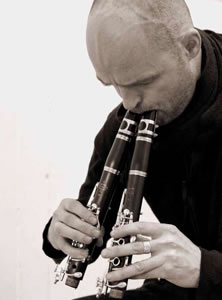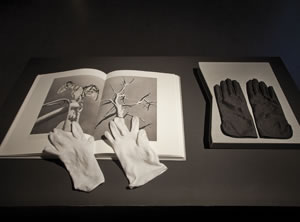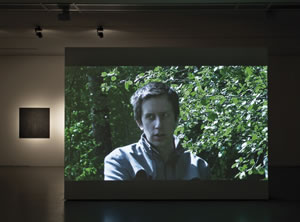
First there was darkness, then someone turned the light switch on and a big empty space was revealed – the second floor of CoCA. One thousand square metres of emptiness.
LEAD ARTIST: JONAS NOBEL (SE)
ARTISTS: MAJA HAMMARÉN (SE) PATRYCJA ORZECHOWSKA (PL) AREK PASOŻYT (PL) CATHAL ROCHE (IE)
In a town called Toruń in Poland, two Swedes, two Poles and one Irishman met. We were all artists and we were told to make an exhibition. We were free to do whatever we wanted. As if by magic we were expected to fill a void – a big empty void in the form of an art space. We started talking, presenting our artistic practices to each other without any concern for time. Our presentations lasted for hours and the hours stretched to days.
Often we got stuck in translation. Language is such a blunt tool when talking about art. Talking about your practice is hard enough in your native tongue; in English it becomes a struggle. We showed each other PowerPoint presentations of our work. What can be said? What can be understood of what has been said? In between the image of the work and what was said about the work, I started to imagine a deep dark emptiness. Misunderstandings became a meaningful form of communication, a point in the PowerPoint, of very high density, a density which our limited language skills could not reach. This density was connected to images of earlier works. The low-resolution images of the PowerPoint had a higher degree of resolution than our common language. I started longing to experience the works outside their pale existence on the screen in the conference room. Rather than forcing the team to produce new work in a workshop I decided that I wanted to experience these works for real. I wanted to take them from their low-resolution life on a pale screen in the conference room to the physical space of CoCA. And just like the artists had met, the artworks would interact with each other, and it was interesting to see what would come out of a communication between physical things.
——–
 The title of the show was borrowed from a work by Cathal Roche called Please Call Stella, a work in which he musically translates a seemingly nonsense text beginning with the words ‘Please Call Stella’. The text was composed by linguists in order to have all the sounds of the English language represented. Cathal mimics their intonations with the fragile sound of a harp. Layer upon layer of understanding is revealed and a new knowledge beyond language appears. A poetic reality is understood. Who is Stella? Is it a person or maybe it should be translated into Latin – star? Someone is begging someone to contact a star floating in the universe. Is Cathal’s musical translation made to communicate with the stars? Why does the star need a shopping list? We called Stella and we brought things back and placed them in the big dark void of CoCA. Please Call Stella was an exhibition about physical objects but also the dark emptiness between them. This dark emptiness resembles the possibilities and the problems of a space like CoCA.
The title of the show was borrowed from a work by Cathal Roche called Please Call Stella, a work in which he musically translates a seemingly nonsense text beginning with the words ‘Please Call Stella’. The text was composed by linguists in order to have all the sounds of the English language represented. Cathal mimics their intonations with the fragile sound of a harp. Layer upon layer of understanding is revealed and a new knowledge beyond language appears. A poetic reality is understood. Who is Stella? Is it a person or maybe it should be translated into Latin – star? Someone is begging someone to contact a star floating in the universe. Is Cathal’s musical translation made to communicate with the stars? Why does the star need a shopping list? We called Stella and we brought things back and placed them in the big dark void of CoCA. Please Call Stella was an exhibition about physical objects but also the dark emptiness between them. This dark emptiness resembles the possibilities and the problems of a space like CoCA.
 The work Wall by Patrycja Orzechowska deals with an event that took place in another time, in an unknown place. The main story has already been told. The fireworks have already gone off and we can only hope that someone saw them. It must have been a hell of a show somewhere, sometime. A show that now takes place in the minds of others, translated and remembered in unforeseen ways. The viewer is softly drawn towards an endless after-party and a happy New Year. In the ongoing project DEADLINE. Never Ending Story, Patrycja collects texts about the ocean and illustrates them in a book. When she stumbles across a text or image she finds interesting she adds them to the book. It is like a miniature search engine on the Internet where the artist is God/Google, presenting another personal understanding of the ocean. For this exhibition she added one of my texts, taken from the work Display of Loss This Play We Lost. Patrycja translated the text into Polish, which in a way made it her own.
The work Wall by Patrycja Orzechowska deals with an event that took place in another time, in an unknown place. The main story has already been told. The fireworks have already gone off and we can only hope that someone saw them. It must have been a hell of a show somewhere, sometime. A show that now takes place in the minds of others, translated and remembered in unforeseen ways. The viewer is softly drawn towards an endless after-party and a happy New Year. In the ongoing project DEADLINE. Never Ending Story, Patrycja collects texts about the ocean and illustrates them in a book. When she stumbles across a text or image she finds interesting she adds them to the book. It is like a miniature search engine on the Internet where the artist is God/Google, presenting another personal understanding of the ocean. For this exhibition she added one of my texts, taken from the work Display of Loss This Play We Lost. Patrycja translated the text into Polish, which in a way made it her own.
 Maja Hammar.n presented a film that was part of a more extensive work called Storyteller Journalisten som ville vara en björn (Storyteller the Journalist Who Wanted to Be a Bear). The film is an interview with the well-known Swedish radio journalist Eric Schüldt. The strange feeling of recognition may only be felt by a Swedish radio audience, but it is nevertheless important. It serves as a background to many of the levels of stories in the film. The film shows an informal interview with the journalist about his profession, the journalist being the interviewee. What does he feel are important stories to tell? And how does he translate them? As the film and the talk continue, the famous journalist informs us that he is in fact a honey-eating bear with a straw hat. Is he serious? Or rather, on hearing can we ever listen to his radio documentaries again without thinking of the storyteller as a honey-eating bear? Does it matter who tells the stories or how they tell them? Stories are told not only with ink on paper, on screens or through microphones, they are written in our brains and alter the way we conceive of the world.
Maja Hammar.n presented a film that was part of a more extensive work called Storyteller Journalisten som ville vara en björn (Storyteller the Journalist Who Wanted to Be a Bear). The film is an interview with the well-known Swedish radio journalist Eric Schüldt. The strange feeling of recognition may only be felt by a Swedish radio audience, but it is nevertheless important. It serves as a background to many of the levels of stories in the film. The film shows an informal interview with the journalist about his profession, the journalist being the interviewee. What does he feel are important stories to tell? And how does he translate them? As the film and the talk continue, the famous journalist informs us that he is in fact a honey-eating bear with a straw hat. Is he serious? Or rather, on hearing can we ever listen to his radio documentaries again without thinking of the storyteller as a honey-eating bear? Does it matter who tells the stories or how they tell them? Stories are told not only with ink on paper, on screens or through microphones, they are written in our brains and alter the way we conceive of the world.
 Arek Parasite hired an anonymous family to paint his paintings for the exhibition, one black and one white spiral painting. The family is from the area in Toruń in which he grew up, and he came in contact with them through local social workers. They got paid about 2000 zloty to paint the two paintings. The money was the equivalent of each artist’s production budget for the exhibition. Arek played the role of employer, but also posed questions such as: what is work doing to us as individuals? Why is unemployment often considered a form of failure? It is hardly the individual’s fault that they are unemployed. And what happens when we no longer need humans as workers, when we have removed ourselves from the chain of production?
Arek Parasite hired an anonymous family to paint his paintings for the exhibition, one black and one white spiral painting. The family is from the area in Toruń in which he grew up, and he came in contact with them through local social workers. They got paid about 2000 zloty to paint the two paintings. The money was the equivalent of each artist’s production budget for the exhibition. Arek played the role of employer, but also posed questions such as: what is work doing to us as individuals? Why is unemployment often considered a form of failure? It is hardly the individual’s fault that they are unemployed. And what happens when we no longer need humans as workers, when we have removed ourselves from the chain of production?
I made a new piece based on the storage of CoCA’s plinths. In the parking lot of CoCA there was a graveyard of plinths. Every art institution has one. I wanted to give this body of corpses new life, and make them dance in their former temple, as well as telling a story about forgotten achievements in supporting and displaying art. The work got the title Empty Museum, a Choreography for Used Plinths. It was also a way of communicating with Cathal Roche’s musical piece by letting the dead objects dance to his piece Please Call Stella. The work is a continuation of an earlier installation called Display of Loss – This Play We Lost in which I exhibited a lot of empty jewellery display boxes. The show focused on display systems and what they can add to the object they are supposed to display. Is contemporary art a display system? If that is the case, what is it displaying? The installation was supported by a short text about a boat crew being shipwrecked – the same text that was included in Patrycja Orzechowska’s DEADLINE. Never Ending Story.
In the last room of the exhibition, the participating artists made a translation in clay of the things on Stella’s shopping list, attempting to even further broaden the act of translation into the realm of materializing language in a physical form.
The exhibition space was left in its raw state with the marks of former exhibitions as a way of showing what goes on behind the scenes of an institution like CoCA, and a way for the five artists to thank everyone working at CoCA for inviting us. After and before every show there is a lot of work that is not visible to the audience. During the exhibition someone cleans the floors, mostly on Mondays when the museum is closed. In order to highlight this activity the artists didn’t paint the walls and polished only a portion of the floor into a pathway for the audience. It is through contrast that the world is discovered. If everything was white and clean nothing would exist. It’s the dirt that defines the clean and the black that defines the white.
Jonas Nobel studied at the Umeå Academy of Fine Arts, and now lives and works in Stockholm. His interdisciplinary practice involves both art and design. He is one of the founder members of Uglycute, which merges art, design and architecture. Jonas has created a permanent installation for Restaurant Riche in Stockholm, and has participated in numerous exhibitions, including the previous Moderna Exhibition in 2006 at Moderna Museet, Stockholm. In 2007, his book, ‘The memory of this experience will fade and you will eventually die Iʼ m sorry Iʼ m so very very sorry’ was designed by Research and Development.
Uglycute is a design and architecture office based in Stockholm, Sweden. Founded in 1999 by Andreas Nobel, interior designer; Fredrik Stenberg, architect; and Markus Degerman and Jonas Nobel, artists. Uglycute are working to expand the concept of design by crossbreeding it with their different professions and trying to analyse its impact on society by not only practicing but also writing, teaching and organising workshops.
Maja Hammarén is an artist and writer engaged in the acting body, the power of language and performativity, collective experiences and narrator positions. In her works she explores art, aesthetics and language as tools for political regimes and economic interests. What languages are used? How does ‘new liberal’ sound? How does ‘national socialism’ sound? And what do these look like – a business company; a PR expert; and a liberation struggle among slaves?
In her work, Patrycja Orzechowska uses photography, collages, installation, graphic design, art books and interventions in the public space. She is interested in the choreography of the body and how it inscribes into various structures or constructions, as a form which that serves both: the vain attempt of restoring the proper order of things in our social and family life as well as searching for harmony in the urban tissue. That is why in her practice she often refers to a variety of performing arts, cooperating with modern dancers, gymnasts and actors. She creates artworks with the human figure as the main motif. The bodies subjected by hershe subjects to an innocent training become structured compositions of disturbing shapes. She treats her work as a field of experiment and experience, therefore, apart from drawing inspiration from the study of psychology or sociology, she eagerly reaches for risky practices and methods such as constellations or astrology in order to use them to create an alternative theatrical (or supposed image) of reality, which is seen from a new point of view.
An artist is bound to create art – it is both his occupation and raison d’être. He earns his living by either selling products, or by organising exhibitions or performances. However, it is not uncommon that an artist, despite putting best efforts into his work, cannot support himself. He is forced to gradually abandon his love for art, in favour of a profitable career. Thus, he dies as an artist. In order to survive – or even make art lucrative – I embraced the idea of parasitismology.
Cathal Roche is a multi-instrumentalist, composer and soundartist based in the north-west of Ireland. Specialising in solo improvisational saxophone performance, Cathal began performing as a free improviser and jazz musician in 1999. After relocating his practice from Dublin city to County Leitrim in 2001, Roche began developing a more personalized saxophone sound language through a prolonged isolated study of local birdsong, weather, intonational phonology, extended saxophone techniques, improvised dance, and spatial multi-tracked composition.
Cathal is drawn to working closely with both groups and individual professionals in other fields and disciplines. In the creation of new performance, Cathal has engaged with dancers, actors, visual artists, writers, composers, musicians, engineers, linguists, teachers, doctors, patients, schools and others. His performance/installation work aims to engage equally with environment, architecture, audience and theatre, using sound performance to give tone to shimmering, whispering and unspeakable questions, and to excavate himself and the audience deeper through the resonance of fundamental tones and their multiple harmonics.